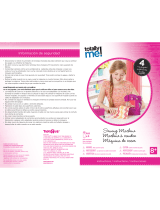
SECTION 1. ESSENTIAL PARTS
Names of Parts ..........................................................2
Standard Accessories ................................................4
SECTION 2. GETTING READY TO SEW
Connecting Machine to Power Supply .......................6
Before Using Your Sewing Machine ...........................6
For Your Safety ........................................................... 6
Polarized plug ............................................................6
Controlling Sewing Speed..........................................6
Extension Table ......................................................... 8
Free Arm Sewing ....................................................... 8
Accessory Storage Box..............................................8
Presser Foot Lifter......................................................8
Changing Presser Foot ............................................10
To Remove and Attach the Foot Holder ...................10
To Drop or Raise the Feed Dogs..............................10
Changing Needle .....................................................12
Thread and Needle Chart ........................................ 12
Reverse Stitch Control .............................................14
Setting Spool Pins....................................................14
Removing or Inserting the Bobbin Case ..................14
Winding the Bobbin .................................................. 16
Threading the Machine ............................................18
Needle threader .......................................................18
Drawing Up Bobbin Thread......................................20
Balancing Needle Thread Tension...........................20
Adjusting Bobbin Thread Tension ............................ 22
Pattern Selector Dial ................................................22
Stitch Length Dial ..................................................... 22
Stitch Width Dial.......................................................22
SECTION 3. BASIC SEWING
Straight Stitch Sewing .............................................. 24
To Change Sewing Direction.................................... 24
Use the Seam Guides .............................................. 24
Variable Needle Position .......................................... 26
Zigzag Sewing..........................................................26
SECTION 4. UTILITY STITCHING
Overcasting .............................................................. 26
Tricot Stitch .............................................................. 28
Knit Stitch ................................................................. 28
Straight Stretch ........................................................30
Rick-rack Stretch ...................................................... 30
Button Sewing .......................................................... 32
Automatic buttonhole ..........................................34-36
Corded Buttonhole ...................................................38
Zipper Application ....................................................40
Blind Stitch Hemming...............................................42
Rolled Hem .............................................................. 44
Stretch Stitch Patterns .............................................. 46
Smocking ................................................................. 46
Applique ...................................................................48
Decorative Satin Stitch Patterns ..............................48
SECTION 5. CARE OF YOUR MACHINE
Cleaning the Bobbin Case and the Hook.................50
Cleaning the Feed Dog ............................................50
Sewing Light ............................................................52
Oil the Machine ........................................................52
Troubleshooting........................................................54
IV
TABLE OF CONTENTS





















